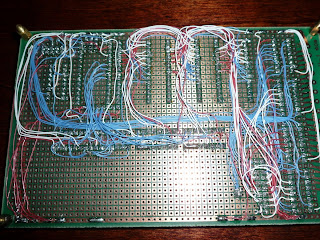 This circuit is designed to take the 4MHz clock coming off of the EDE707 and use it to drive a couple multiplexers and buffers (I ended up using a pair of 74LS12[56] chips instead of the 74F257). The intended waveform is shown at the top right. The CLK signal (a direct down-clock of the 4MHz) will be used to drive the LATCH pin of the EDE707. Qa will be used to select which set of inputs to use (address pins, or Qb/Qc/0/0). Qb and Qc will be used to drive the multiplexers so that the right part of the input shows up on the EDE707 inputs at the right time. Easy, right?
This circuit is designed to take the 4MHz clock coming off of the EDE707 and use it to drive a couple multiplexers and buffers (I ended up using a pair of 74LS12[56] chips instead of the 74F257). The intended waveform is shown at the top right. The CLK signal (a direct down-clock of the 4MHz) will be used to drive the LATCH pin of the EDE707. Qa will be used to select which set of inputs to use (address pins, or Qb/Qc/0/0). Qb and Qc will be used to drive the multiplexers so that the right part of the input shows up on the EDE707 inputs at the right time. Easy, right?Here's what the program counter board looks like now:

Here's a front view with the various sockets/chips described.

So far so good, right? Well, not so much. After wiring up the 2:4 multiplexers and the quad tristates, the program counter board is now suffering from a bug such that all outputs are now held high all the time. No freaking idea why. I spent half an hour with a multimeter trying to find something resembling a short circuit, and couldn't find one.
I thought maybe it was some weird situation where a "high" output was wired to a "low" output and was thus causing a short, so I pulled all of the ICs out of the board. But even with no ICs in the board, it's still sending all of the outputs high. Which is even more bizarre, because the various output pins are isolated from each other (even more so with the ICs removed). So why would they all register +5v when the board is plugged in, even when there are no ICs in the board?
The other possibility is that my logic analyzer is no longer properly calibrated. I did notice that it said "default calibration settings loaded" the last time I booted it up.
So more research and debugging is to come. For now, however, I effectively have a paperweight that I spent a dozen hours to create. Lame.



